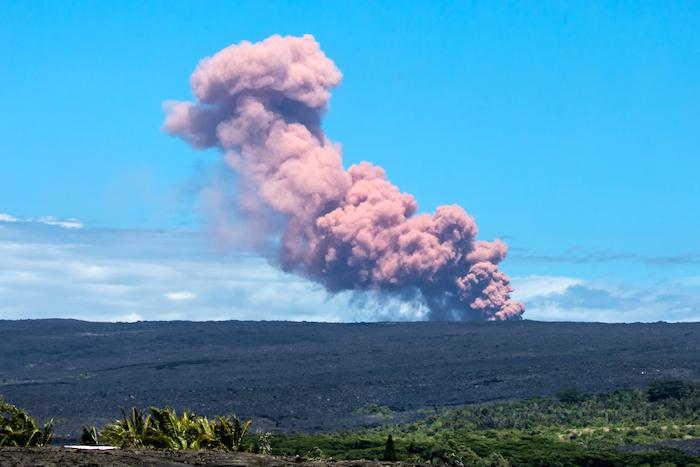
The eruption of Kīlauea volcano earlier this year changed the experience of Hawai'i Volcanoes National Park./NPS
When Hawai'i Volcanoes National Park reopens more of the park on September 22, National Public Lands Day, visitors will find a changed park in many respects, and yet one that has been going through these changes for hundreds of years, if not longer.
When Lieutenant Charles Wilkes landed his U.S. Exploring Expedition at the Big Island in 1839 and traveled with a team of scientists to the Kīlauea volcano, the scene they encountered seems little changed from what has transpired at the national park for much of this year.
"Dr Judd ... turned towards the west bank, on which he mounted to a higher level over stones too hot to be touched, but from which his feet were defended by stout woollen stockings and sandals of hide worn over his shoes. When he had proceeded as far as he could in this direction, he saw at the distance of about thirty feet from him, a stream of lava running down the declivity over which he and his companions had ascended," read the expedition's log. "Even this distance was too great to be reached over, and the intervening rocks had become so heated by the continual stream, that they could not be traversed.
"At this time, they were very near the great lake, but could not see its surface, which was still about twenty feet higher than the spot where they stood. Jets of lava were, however, observed rising about twenty-five feet, and falling back again into the lake. Dr Judgg now despaired of gratifying his own wishes and mine, by obtaining lava in the liquid state, and ordered a retreat."
The National Park Service won't allow you to get this close to the park's volcanics; indeed, for the first time in years there will be no molten lava for visitors to see, the park staff said. However, they are working to be able to show you some of the other wonders of their park later this month.

A visit to Hawai'i Volcanoes National Park should include a walk through the Thurston Lava Tube/Rebecca Latson file
So far, 32 buildings have been inspected, non-potable water has been restored to nine buildings, and 20 miles of trail have been assessed by the Park Service geomorphologist. On Sept. 10, a team of engineers from the Federal Highway Administration will begin assessments on park roads. Due to extensive earthquake damage, no vehicles over 15,000 pounds will be allowed to enter the park when it reopens.
The park is preparing to reopen the following areas on September 22 by 10 a.m.:
· Kīlauea Visitor Center (closes at 5 p.m.)
· Hawai‘i Pacific Parks Association store at Kīlauea Visitor Center (closes at 5 p.m.)
· Crater Rim Trail between Volcano House and Kilauea Military Camp
· Sulphur Banks Trail
· Crater Rim Drive to Steam Vents
· Kīlauea Iki Overlook and parking lot
· Devastation Trail and Pu‘u Pua‘i
· Crater Rim Drive to Keanakāko‘i Crater, for pedestrians and bicyclists only
· Mauna Loa Road to Kīpukapuaulu; open to pedestrians and bicyclists past Kīpukapuaulu
· Sections of Escape Road from Highway 11
· Chain of Craters Road
The Volcano Art Center Gallery and Kilauea Military Camp also plan to open on September 22. Limited services may be available at Volcano House. The park's entrance station will open by 10 a.m. that day, and the park will go back to being open 24 hours a day.
There is no drinking water in the park. Unforeseen circumstances could delay the projected reopening. During the last several weeks, two hurricanes threatened the park, and a damaging wildfire burned nearly 3,800 acres of native forest on Mauna Loa.
An initial interior inspection was completed on Nāhuku (Thurston Lava Tube), but additional assessments are needed before it is reopened to the public. Between May and August, 62 collapse-explosion events at the summit of Kīlauea produced scores of rockfalls and fractured park overlooks, trails, waterlines, parking lots and roads.
You can follow the park's rebirth at this website.

A special presentation will be held September 25 to present the native islanders' view of Pele and the volcanics at the national park/USGS
For those fortunate enough to visit the park late this month, there will be a special presentation on September 25 by cultural practitioner, professor, and researcher Leialoha Kaleimamahu of Kaimu and Mokuhulu in Puna, who will offer a Hawaiian perspective of Kīlauea’s current eruptive activity. You'll be able to learn about Pele through chant, mele, and moʻolelo (stories) passed down from generation to generation.
If the Thurston Tube is open, be sure to check it out. It'slocated near the summit of Kīlauea Volcano off Crater Rim Drive. Nāhuku and its lush rainforest trail are popular features in the park. An eruption from Kīlauea 550 years ago produced vigorous streams of lava, and the long, hollow tunnel was left behind when the molten rock drained away.



Add comment